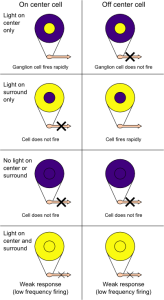Light and Eyeballs
77
Learning Objectives
Know what the center-surround receptive field is.
Be able to describe the differences between an ON-center and OFF-center receptive field.
Know what types of retinal cells have the center-surround receptive fields.
A visual receptive field is defined as the region of visual space in which a change in lightness or color will cause a change in the neuron’s firing rate. Almost all receptive fields have structure—different changes in different parts of the receptive field will have different effects on the neuron’s response. A key function of this receptive field structure is that neurons only respond to edges. When center and surround are balanced, the RGC (retinal ganglion cell) will not change its firing rate in response to uniform illumination.

Most neurons in the retina and thalamus have small receptive fields that have a very basic organization, which resembles two concentric circles. This concentric receptive field structure is usually known as center-surround organization. On-center retinal ganglion cells respond to light spots surrounded by dark backgrounds like a star in a dark sky. Off-center retinal ganglion cells respond to dark spots surrounded by light backgrounds like a fly in a bright sky.
CC LICENSED CONTENT, SHARED PREVIOUSLY
Cheryl Olman PSY 3031 Detailed Outline
Provided by: University of Minnesota
Download for free at http://vision.psych.umn.edu/users/caolman/courses/PSY3031/
License of original source: CC Attribution 4.0Scholarpedia, “Receptive field” by Dr. Jose-Manuel Alonso & Dr. Yao Chen, SUNY State College of Optometry
URL: http://www.scholarpedia.org/article/Receptive_field
License: CC BY-NC-SA 3.0

